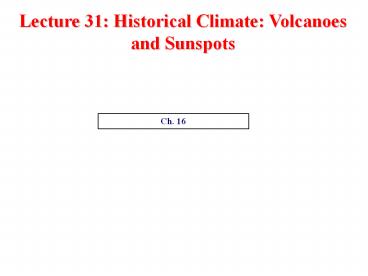Proxy Climate Data - PowerPoint PPT Presentation
Title:
Proxy Climate Data
Description:
Lecture 31: Historical Climate: Volcanoes and Sunspots Ch. 16 The Earth s Climate History The Earth s Climate History How do volcanoes affect climate? – PowerPoint PPT presentation
Number of Views:54
Avg rating:3.0/5.0
Title: Proxy Climate Data
1
Lecture 31 Historical Climate Volcanoes and
Sunspots
Ch. 16
2
Historical Climate Volcanoes and Sunspots
Ch. 16, p. 352-381 p. 381
- How do volcanoes affect climate?
- Name two important volcanic eruptions in the
past one hundred years.
- How do sunspots affect climate?
- In what way do sunspot cycles before the 20th
century imply a Sun-climate connections?
- Did volcanic eruptions and El Nino events affect
the gradual trend of global temperature over the
last century?
3
Climate Change Since the Last Glacial Maximum
About 1000 y.a., the N.H. was cooler than now
(e.g., 1961-1990 average). Certain regions were
warmer than others.
4
The Earths Climate History
- Over the last century, the earths surface
temperature has increased by about 0.75C (about
1.35F). - Little Ice Age Cooling during 1,400 A.D.
1,900 A.D. (N.H. temperature was lower by 0.5C,
alpine glaciers increased few sunspots, low
solar output) - Medieval Climate Optimum (Warm Period) Warming
during 1,000 A.D. 1,300 A.D. in Europe and the
high-latitudes of North Atlantic (N.H. warm and
dry, Nordic people or Vikings colonized Iceland
Greenland) - Holocene Maximum 5,000-6,000 ybp (1C warmer
than now, warmest of the current interglacial
period) - Younger-Dryas Event 12,000 ybp (sudden drop in
temperature and portions of N.H. reverted back to
glacial conditions) - Last Glacial Maximum 21,000 ybp (maximum North
American continental glaciers, lower sea level
exposed Bering land bridge allowing human
migration from Asia to North America) - We are presently living in a long-term Icehouse
climate period, which is comprised of
shorter-term glacial (e.g., 21,000 ybp) and
interglacial (e.g., today) periods. There were
four periods of Icehouse prior to the current
one. - For most of the earths history, the climate was
much warmer than today.
5
Tropospheric Stratospheric Aerosols
Auto emissions and wild land fires are 2 sources
that emit aerosols into the troposphere that
reduce incoming radiation and have a net cooling
effect on earth's surface. Volcanic eruptions
push aerosols into the stratosphere. Large
eruptions, such as Mt. Pinatubo, have been linked
to significant cooling episodes.
6
Mt. Pinatubo Eruption Impact
Three months after the June 1991 eruption of this
Philippine volcano, much of the 20 million tons
of ejected sulfur dioxide had been directed by
zonal stratospheric winds and girdled the equator.
Recorded changes in air temperature indicates the
volcanic impact on climate.
7
Brief Episodes of Volcanic Cooling and El Nino
Warming
8
Climate Change and Variations in Solar Output
More sunspots, stronger solar emissions from the
Suns polar regions and from the bright margins
of sunspots.
9
Sunspot History from Telescopes
The telescope records show 11-year sunspot
cycle, The Maunder minimum.































